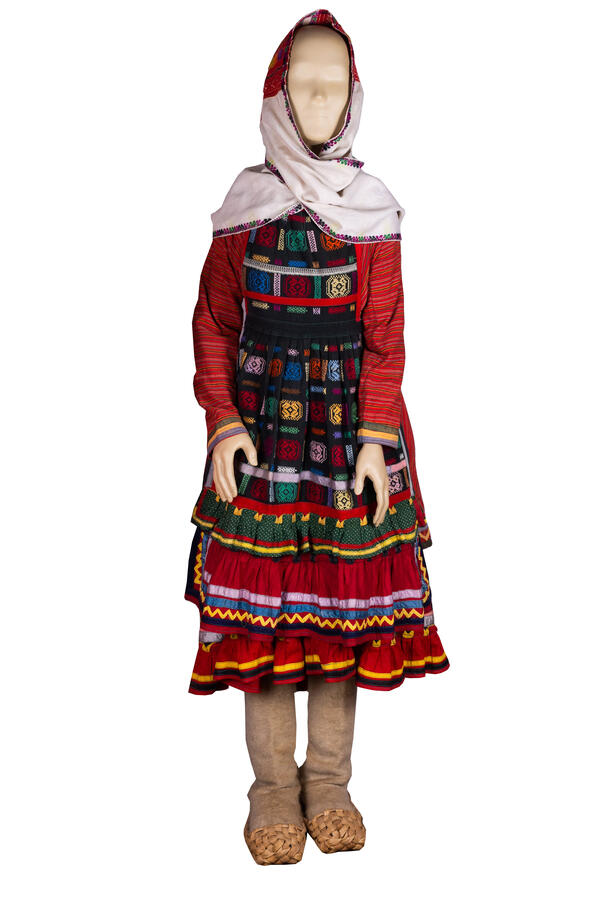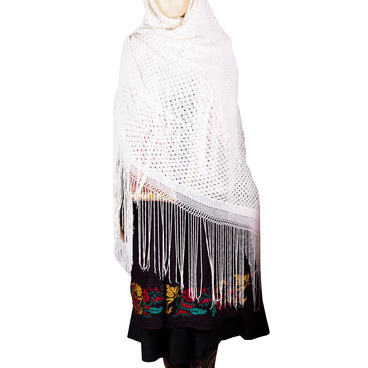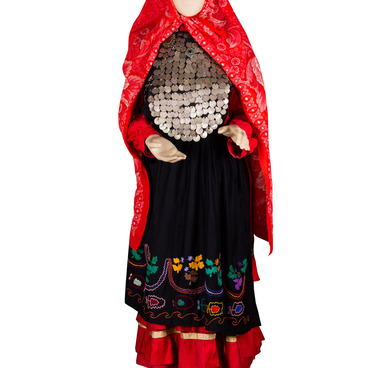Both male and female Mari folk costumes consisted of a shirt, kaftan, trousers, a belt with decorative pendants, a head covering, and leather shoes or bast shoes with woolen and canvas leggings. The undershirt, called a tower or tiger, was cut like a tunic: a canvas cloth bent in half formed the front and back of the shirt, and the sleeves were sewn to it at right angles. Women’s costumes were often supplemented by jewelry worn on the neck, chest, and waist, and by earrings, rings, and bracelets. The Mari women themselves sewed their traditional costumes from homespun canvas.
The Mari women’s folk costume was distinguished by its sophistication and variegation. The shirt had a wide hem and the woven patterns, frills, and ribbons that were sewn into it. Belts, aprons, and waist ornamentation were important components in the Mari women’s costume. Belts were divided into two categories: everyday ones and those worn during celebrations. Aprons were an integral part of the women’s costume. They could cover the shirt down to the chest or waist, and were often decorated with ceremonial embroidery, braiding, and lace. In the women’s Mari costume on display in the museum, it is the refined apron with spectacular contrasting patterns that particularly draws attention to itself.
Head coverings were also common among the Mari, and they indicated the age and social status of person wearing them. This head covering is called a sharpan, which is a headdress worn by married Mari women. The sharpan is a direct counterpart of the headdresses worn by other Turkic peoples — the Bashkirs, Tatars, and Chuvash — and apparently it was adopted from those. A triangular scarf was sometimes worn over the first headdress, and a quadrangular one was worn on top of that. In the wintertime, Mari women wore warm shawls woven from woolen threads.
The traditional Mari costume was richly decorated with unique embroidery, as well as red calico inserts and braiding. Embroidery on the shirts was placed on the collar, chest, back, sleeve cuffs, and hem. The embroidery served as a talisman, and the Mari believed that it protected people from diseases and the evil eye. The ornamentation on the clothing also reflected a person’s gender, age, and social status. The embroidery was done mainly with red woolen or silk threads that had various shades ranging from dark red to brown.
The Mari women’s folk costume was distinguished by its sophistication and variegation. The shirt had a wide hem and the woven patterns, frills, and ribbons that were sewn into it. Belts, aprons, and waist ornamentation were important components in the Mari women’s costume. Belts were divided into two categories: everyday ones and those worn during celebrations. Aprons were an integral part of the women’s costume. They could cover the shirt down to the chest or waist, and were often decorated with ceremonial embroidery, braiding, and lace. In the women’s Mari costume on display in the museum, it is the refined apron with spectacular contrasting patterns that particularly draws attention to itself.
Head coverings were also common among the Mari, and they indicated the age and social status of person wearing them. This head covering is called a sharpan, which is a headdress worn by married Mari women. The sharpan is a direct counterpart of the headdresses worn by other Turkic peoples — the Bashkirs, Tatars, and Chuvash — and apparently it was adopted from those. A triangular scarf was sometimes worn over the first headdress, and a quadrangular one was worn on top of that. In the wintertime, Mari women wore warm shawls woven from woolen threads.
The traditional Mari costume was richly decorated with unique embroidery, as well as red calico inserts and braiding. Embroidery on the shirts was placed on the collar, chest, back, sleeve cuffs, and hem. The embroidery served as a talisman, and the Mari believed that it protected people from diseases and the evil eye. The ornamentation on the clothing also reflected a person’s gender, age, and social status. The embroidery was done mainly with red woolen or silk threads that had various shades ranging from dark red to brown.



